Barcelona is an exciting city with lots to see and experience. This Catalonian jewel by the Mediterranean Sea is a city that dances to its own unique rhythm, blending ancient history with modern flair. The Gaudi architecture is whimsical and inspirational. I wonder what people thought of these crazy looking organic buildings when they were erected in the late 1800’s. The Sagrada da Familia church nestled in the center of town is a constant work in progress it has been over 140 years of ceaseless creation, like an epic saga unfolding brick by magical brick.
The food is amazing featuring Iberian Ham and lots of fresh seafoods. Around 2pm the tapas bars start to fill up, offering tantalizing bites like patatas bravas (fried crispy potatoes), gambas al ajillo (shrimp), and tortilla española (an omelette with potatoes). Pair these with a glass of cava (Spanish Champagne) or a robust Rioja red wine, and you’re in for a treat.
Life in Barcelona is a blend of laid-back Mediterranean charm and vibrant urban energy. It’s a place where history and modernity coexist in harmony, where every corner holds a story, and where the spirit of creativity and passion is palpable.
Sagrada Da Familia
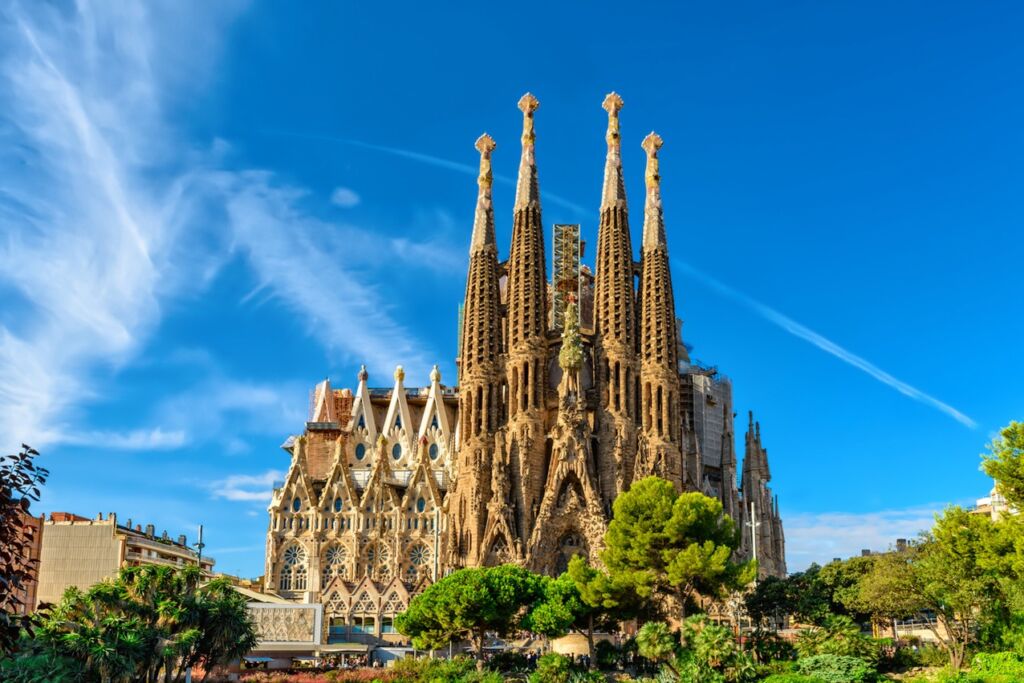
Gaudí began his magical work on this divine edifice in 1882, and it has been growing ever since, like a living organism imbued with the spirit of creativity itself. The exterior is a tapestry of intricate sculptures, each telling stories of biblical lore, while quirky gargoyles and chimeric creatures peek out from corners, almost as if they might spring to life when no one is looking. Inside, the nave is a forest of columns, reaching upwards like trees yearning for the sun, their branches unfolding in a riot of colors as the stained glass windows cast a kaleidoscope of hues upon the floors.
Despite its unfinished state, the Sagrada Família is a symphony of stone, a monument to human imagination and faith. It’s as if the basilica is perpetually under the spell of a master magician, ever-evolving, ever-enchanting, inviting all who behold it to step into a world where the boundaries between the possible and the impossible blur into a tapestry of wonder.
Tip: It is definitely worth doing the tour to see the stunning interior, but be sure to book a couple of days in advance as the tickets sell out.
La Rambla
La Rambla, often simply referred to as Las Ramblas, is one of Barcelona’s most famous and bustling streets, stretching for 1.2 kilometers from Plaça de Catalunya down to the Christopher Columbus Monument at Port Vell. This vibrant boulevard is a lively mix of locals and tourists, street performers, artists, and vendors, creating a dynamic and colorful atmosphere. La Rambla is divided into several sections, each with its own unique character and charm. You can wander through tree-lined pathways, explore historic landmarks, and enjoy the ever-changing street scene that epitomizes the spirit of Barcelona.
A stroll along La Rambla reveals many of Barcelona’s cultural treasures. Highlights include the Mercat de Sant Josep de la Boqueria, a bustling market famous for its fresh produce, seafood, and local delicacies. The Gran Teatre del Liceu, Barcelona’s historic opera house, stands majestically along the street, offering a glimpse into the city’s rich artistic heritage. Another notable landmark is the ornate Font de Canaletes, a fountain said to bring good luck to those who drink from it. With its eclectic mix of sights, sounds, and flavors, La Rambla serves as a microcosm of Barcelona itself, blending tradition and modernity in a way that captivates and delights visitors from around the world.
Montjuïc Funiclar, Montjuïc Cable Car & Port Cable Car
The Montjuïc Funicular is a key transportation system in Barcelona, designed to provide easy access to the scenic Montjuïc Hill. Operating since 1928, it connects the city’s metro system at the Paral·lel station to the lower station on Montjuïc. The funicular covers a relatively short but steep route, efficiently transporting passengers up the hill in just a few minutes.
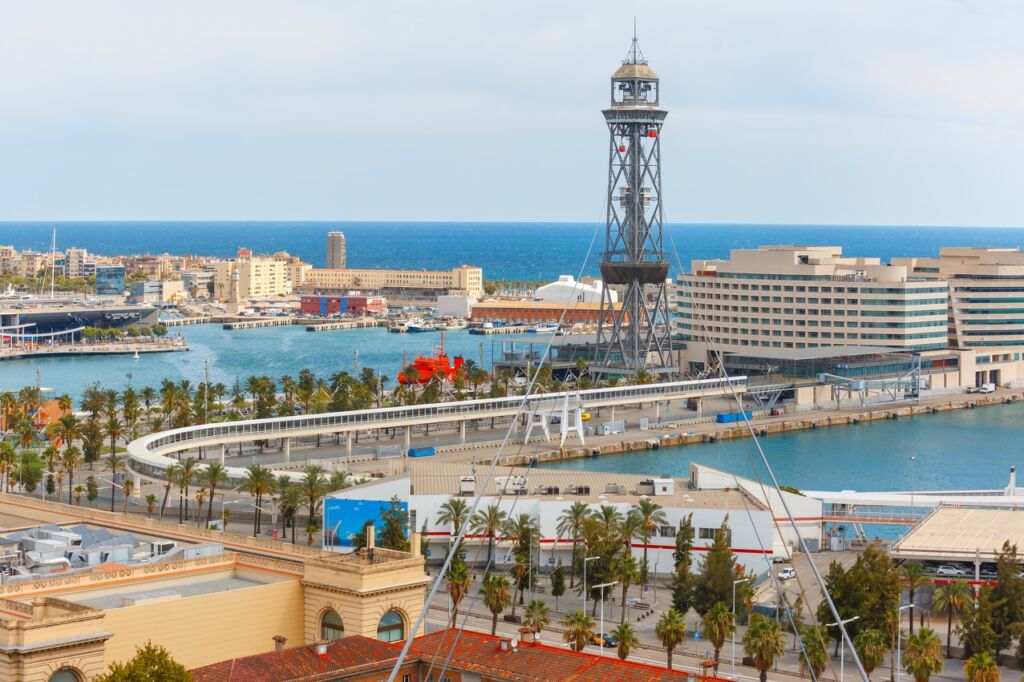
The Montjuïc Cable Car (Telefèric de Montjuïc) takes passengers from the base of Montjuïc Hill to its summit, passing key attractions like the Montjuïc Castle and the Olympic Stadium. Another popular option is the Port Cable Car (Transbordador Aeri del Port), which travels from the beach area of Barceloneta to Montjuïc, crossing over the bustling Port Vell and providing breathtaking views of the city’s coastline. These trams are not only convenient modes of transportation but also memorable experiences that showcase Barcelona’s beauty from a unique vantage point.
Tip: Salts – Terrassa Bar is a casual, order at the bar cafe, perched above the large municipal swimming pool. Here you can cool off and refresh yourself while taking in the views of the city.
Fundació Joan Miró
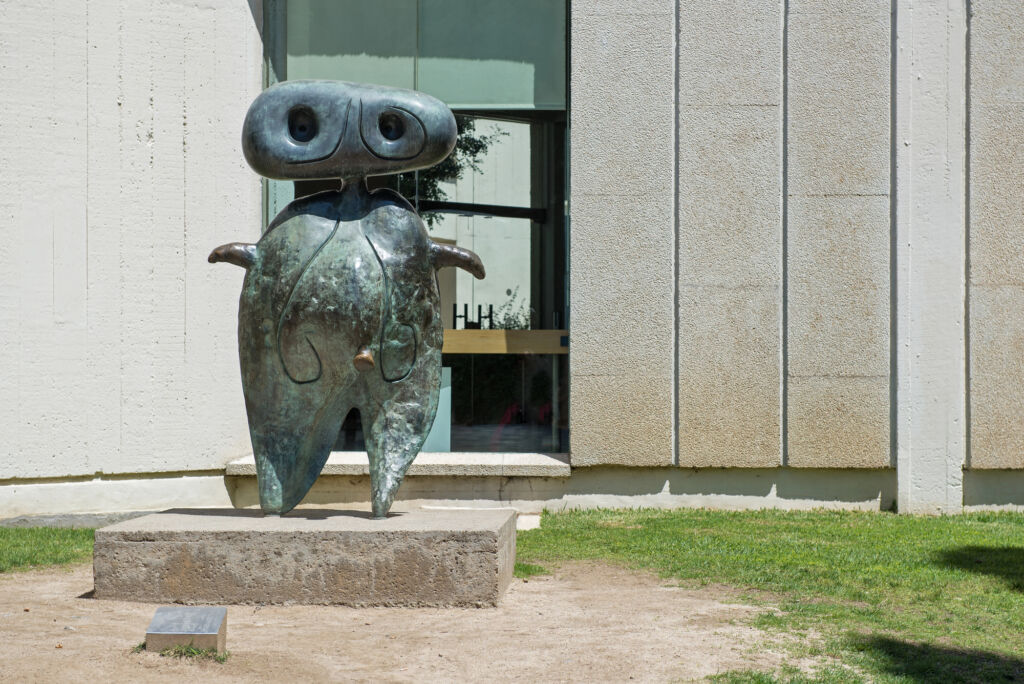
The Fundació Joan Miró, located on Montjuïc Hill in Barcelona, is a museum and cultural center dedicated to the works of the renowned Catalan artist Joan Miró. Established in 1975, the foundation was conceived by Miró himself, with the aim of creating a space that would inspire and promote contemporary art and provide a platform for young artists. The building, designed by Miró’s friend and collaborator Josep Lluís Sert, is a modernist architectural marvel that harmonizes perfectly with its surroundings. Its clean lines, open spaces, and natural light make it an ideal setting for displaying art, fostering a sense of serenity and inspiration.
Inside, the Fundació Joan Miró houses one of the most comprehensive collections of Miró’s works, including paintings, sculptures, textiles, ceramics, and drawings. The collection spans the artist’s entire career, showcasing his evolution from early works influenced by Fauvism and Cubism to his later, more abstract and surreal pieces. Highlights include Miró’s vibrant, large-scale paintings, his whimsical sculptures, and the playful yet profound “Constellations” series. With its stunning location, architectural beauty, and rich collection, the Fundació Joan Miró offers visitors a deep dive into the imaginative world of one of the 20th century’s most influential artists.
Tip: Touring this museum is a great way to cool off after hiking up Montjuic Hill. Get inspired while taking in the stunning views of Barcelona.
Magic Fountain of Montjuïc
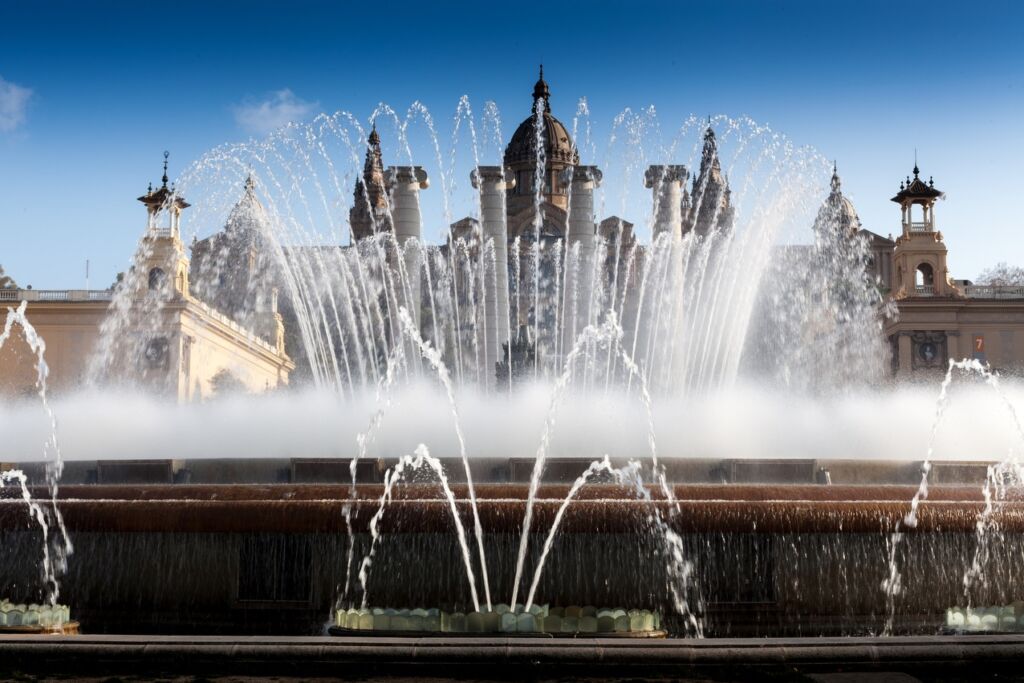
The Magic Fountain of Montjuïc, situated in Barcelona, Spain, is a spectacular fountain known for its impressive light and music shows. Designed by Carles Buïgas and constructed for the 1929 Barcelona International Exposition, the fountain is located at the head of Avinguda Maria Cristina in the Montjuïc neighborhood. It features a series of cascades and pools leading up to the Palau Nacional, now the National Art Museum of Catalonia (MNAC). The Magic Fountain combines water acrobatics with colorful lights and music, creating a captivating performance that draws thousands of visitors each evening. The show includes a variety of music genres, from classical to contemporary, making it a dynamic and engaging attraction.
Palau Nacional
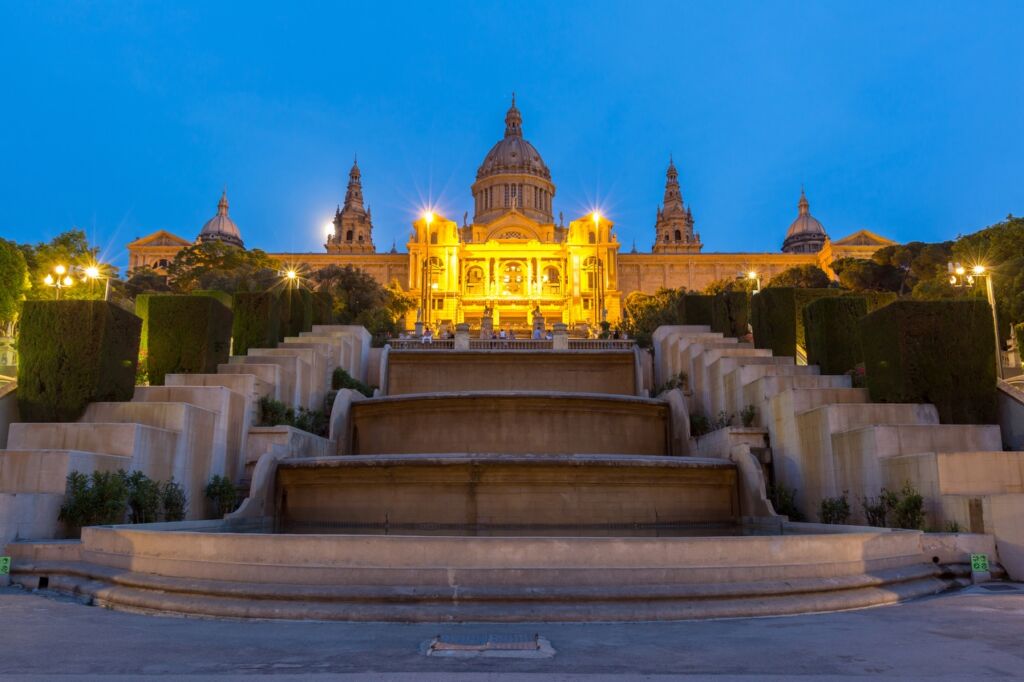
The Palau Nacional, an iconic building on Montjuïc hill, was also constructed for the 1929 International Exposition and originally served as the main exhibition hall. Designed by architects Eugenio Cendoya and Enric Catà, the Palau Nacional is characterized by its grand classical style and impressive dome. In 1934, it became the home of the National Art Museum of Catalonia, housing one of the most important collections of Catalan art from the Romanesque, Gothic, Renaissance, and Baroque periods. The museum’s extensive collection and the building’s architectural grandeur make it a cultural centerpiece of Barcelona. The Magic Fountain and the Palau Nacional together create a visually stunning and historically rich destination, offering visitors both artistic and sensory experiences in one of Barcelona’s most celebrated settings.
Tip: Check what exhibit is showing as there is always something going on here. When we visited there was a Balloon Museum and previously there had been an exhibit “Tim Burton’s Labyrinth” which we saw them breaking down.
Casa Milà – La Pedrera
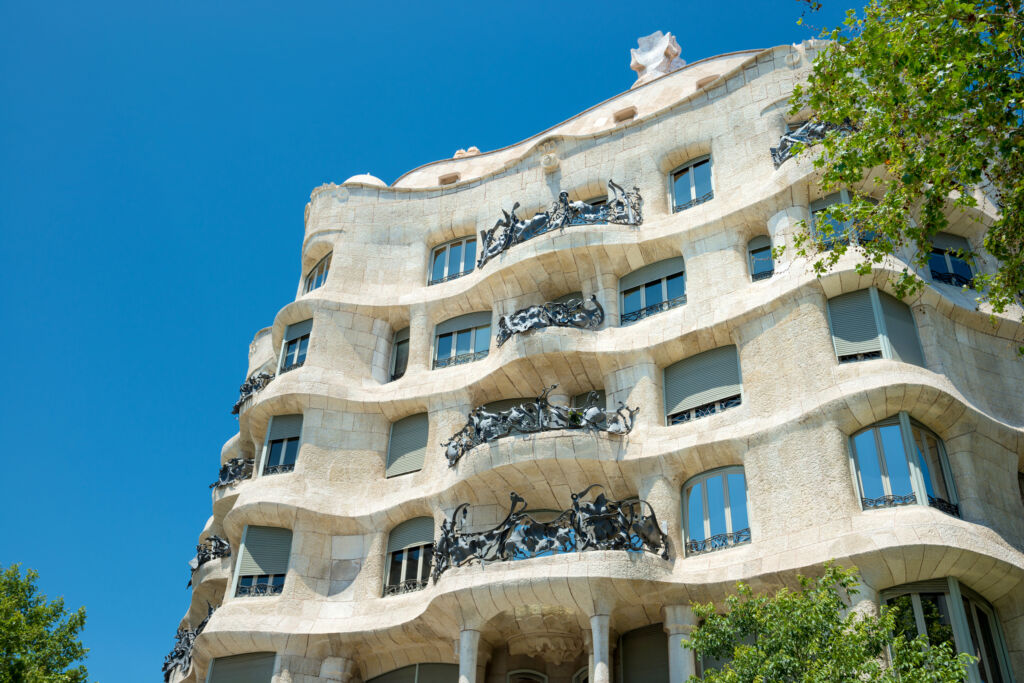
Casa Milà, commonly known as La Pedrera, is one of Antoni Gaudí’s most famous masterpieces, located in the heart of Barcelona. Completed in 1912, this modernist building stands out with its unconventional, undulating stone facade, which gives the impression of a natural rock formation sculpted by time and elements. The design is a testament to Gaudí’s innovative approach to architecture, with its fluid lines, organic shapes, and a lack of straight edges. The facade’s wave-like contours are complemented by intricate wrought-iron balconies and windows, which add a touch of elegance and whimsy to the structure. Casa Milà’s design was groundbreaking at the time and remains a symbol of modernist architecture and Gaudí’s visionary genius.
The interior of Casa Milà is just as remarkable as its exterior. Gaudí’s attention to detail and his ability to blend functionality with aesthetics are evident throughout the building. The apartments feature open, adaptable floor plans, allowing for a fluid use of space, and are filled with natural light from the inner courtyards. The roof terrace, often considered the highlight of the building, is adorned with fantastical chimneys and ventilation towers, resembling surreal sculptures that seem to come alive against the Barcelona skyline. Today, Casa Milà is a UNESCO World Heritage site and a cultural center, hosting exhibitions and events. It continues to draw visitors from around the world who come to admire its architectural brilliance and to be inspired by Gaudí’s boundless creativity.
Tip: The gift store is worth checking out. They have some beautiful high end bags, clothes and jewelry that Gaudi would approve of.
Park Güell
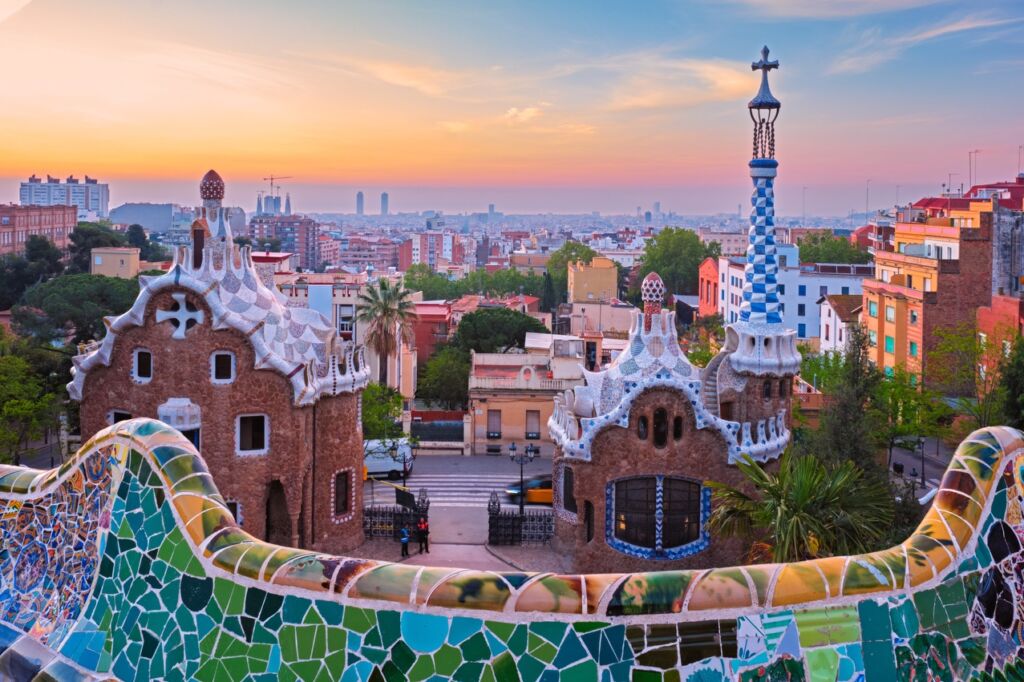
Park Güell, located in Barcelona, Spain, is one of the most iconic and imaginative public parks in the world, designed by the renowned Catalan architect Antoni Gaudí. Originally conceived as a housing development by Eusebi Güell, the project evolved into a public park between 1900 and 1914. Gaudí’s unique vision is evident throughout the park, with its vibrant mosaics, organic shapes, and integration with the natural landscape. The park’s entrance features the famous dragon or salamander fountain, adorned with colorful ceramic tiles, while the main terrace, known as the “Greek Theatre,” offers panoramic views of Barcelona and is lined with a serpentine bench covered in broken ceramic pieces.
In addition to its artistic and architectural significance, Park Güell serves as a testament to Gaudí’s innovative approach to design, blending natural elements with man-made structures. The park’s network of winding paths, viaducts, and steps were carefully designed to follow the natural contours of the hillside, creating a seamless harmony between nature and architecture. Designated a UNESCO World Heritage Site in 1984, Park Güell attracts millions of visitors annually, who come to marvel at Gaudí’s whimsical creations and enjoy the tranquil beauty of this urban oasis. The park is a symbol of Catalan modernism and remains a beloved cultural landmark in Barcelona.
La Boqueria, Parc de la Ciutadella
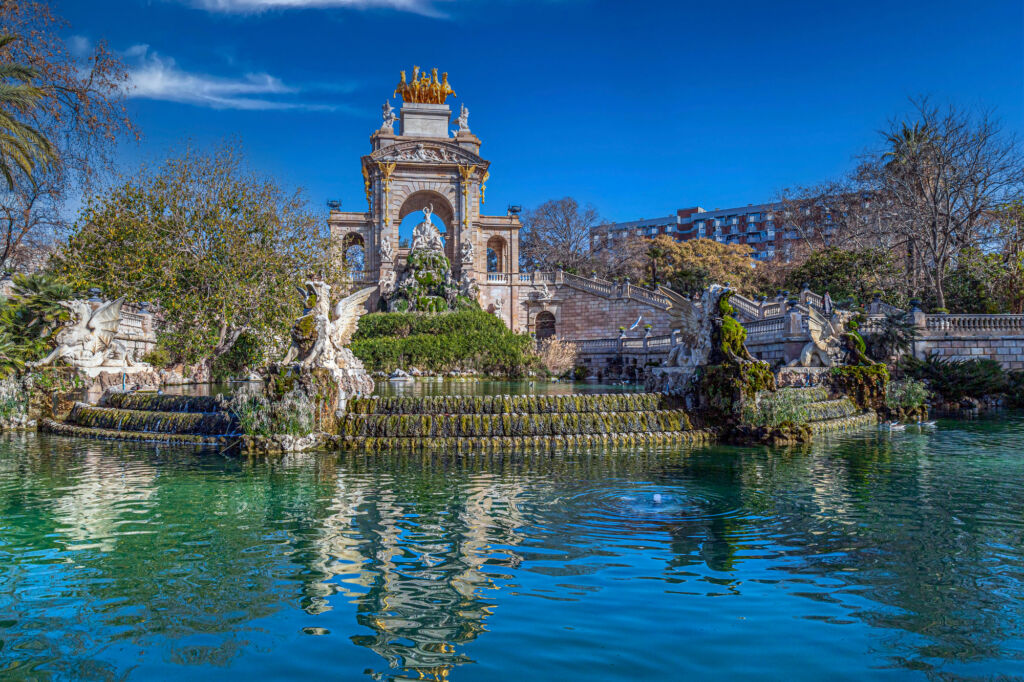
As the day warms, head to La Boqueria, the bustling market brimming with fresh produce, vibrant spices, and local delicacies. The vendors’ calls mix with the chatter of shoppers, creating a lively tapestry of sound and color. Grab some jamón ibérico, olives, and a wedge of cheese for an impromptu picnic at Parc de la Ciutadella, where lush greenery provides a serene escape from the city’s bustle.
The park was designed by Josep Fontsere, with assistance from a young Antoni Gaudí, and was officially opened in 1881. It spans over 70 acres and is home to a wide variety of attractions, including the Barcelona Zoo, the Parliament of Catalonia, and several museums. The park features a diverse range of landscapes and architectural elements, making it a popular destination for both locals and tourists. One of its most notable features is the grand fountain, La Cascada, which was designed by Fontsere with input from Gaudí. The fountain is an elaborate structure adorned with sculptures and greenery, inspired by the Trevi Fountain in Rome.
Passeig de Gràcia
The Passeig de Gràcia district of Barcelona is one of the city’s most prestigious and vibrant areas, known for its luxurious shopping, stunning architecture, and lively atmosphere. This grand boulevard stretches from Plaça Catalunya to the Gràcia neighborhood, acting as a central artery in the heart of Barcelona. Passeig de Gràcia is often compared to Paris’s Champs-Élysées, as it is lined with high-end boutiques, designer stores, and some of the finest hotels and restaurants in the city.
Architecturally, Passeig de Gràcia is a treasure trove of Modernist masterpieces. It is home to several of Antoni Gaudí’s most famous works, including Casa Batlló and Casa Milà (La Pedrera). These buildings are prime examples of Gaudí’s unique, organic style, featuring undulating facades, vibrant mosaics, and intricate ironwork. Alongside Gaudí’s creations, you’ll find other notable buildings like Casa Lleó Morera and Casa Amatller, designed by Domènech i Montaner and Puig i Cadafalch respectively. Each structure on this avenue contributes to its reputation as an open-air museum of Modernist architecture.
In addition to its architectural wonders and upscale retail options, Passeig de Gràcia offers a variety of dining experiences, from trendy tapas bars to Michelin-starred restaurants. The wide, tree-lined sidewalks provide a pleasant environment for strolling and people-watching, making it a favorite spot for both locals and tourists. Whether you’re interested in shopping, dining, or simply soaking up the grandeur of Barcelona’s urban landscape, Passeig de Gràcia is a must-visit destination that captures the essence of the city’s charm and sophistication.
Casa Batlló
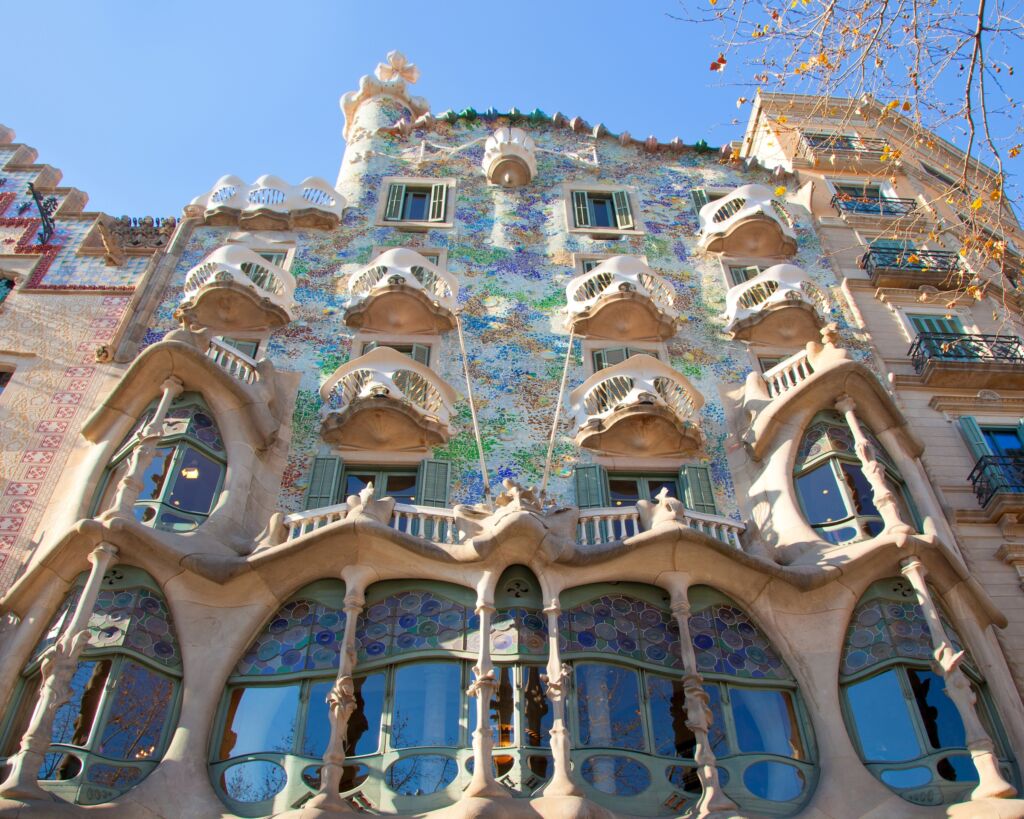
Casa Batlló, often referred to as Casa dels Ossos (House of Bones), is a spectacular modernist building located in the heart of Barcelona. Designed by the visionary architect Antoni Gaudí and completed in 1906, Casa Batlló is renowned for its whimsical and organic design elements that reflect Gaudí’s signature style. The building’s facade is a breathtaking mosaic of colorful tiles, with undulating lines that mimic the waves of the sea. The balconies and window frames resemble masks or bones, giving the structure its eerie, yet enchanting nickname. This architectural masterpiece is a vibrant representation of Catalan Modernism and showcases Gaudí’s extraordinary ability to blend art with nature.
The interior of Casa Batlló is equally mesmerizing, with every detail meticulously crafted to create a seamless flow of design. The central light well is covered in blue tiles that transition from dark to light, creating an illusion of descending into the depths of the ocean. The rooms are adorned with curved woodwork, stained glass windows, and intricate ironwork, all contributing to a cohesive organic aesthetic. One of the highlights is the Noble Floor, which features an expansive, flowing space filled with natural light and offering stunning views of Passeig de Gràcia. The roof terrace, with its dragon-like spine and whimsical chimneys, adds a fairy-tale element to the building. Casa Batlló, now a UNESCO World Heritage site, continues to captivate visitors from around the world, standing as a testament to Gaudí’s unparalleled creativity and his ability to transform architecture into a dreamlike experience.
La Barceloneta
La Barceloneta is a charming and lively seaside district in Barcelona, known for its sandy beaches, seafood restaurants, and vibrant maritime atmosphere. Originally a fishing village, La Barceloneta was built in the 18th century to house the city’s displaced residents. Today, it retains its historic charm while offering a plethora of modern attractions, making it a popular destination for both locals and tourists.
The heart of La Barceloneta is its expansive beach, one of the most famous urban beaches in Europe. Here, you can enjoy sunbathing, swimming, and a variety of water sports. The beachfront promenade is perfect for leisurely strolls, cycling, or rollerblading, with numerous bars and cafes offering refreshing drinks and delicious tapas. The neighborhood is also renowned for its seafood cuisine, with many restaurants serving fresh catches of the day in traditional dishes like paella and fideuà. In addition to its culinary delights, La Barceloneta hosts the iconic W Barcelona Hotel, known for its sail-like shape, and the bustling Mercat de Barceloneta, where you can experience local life and flavors.